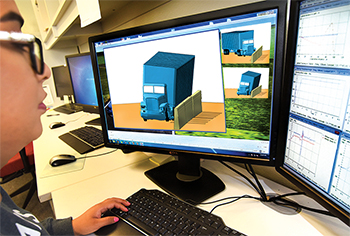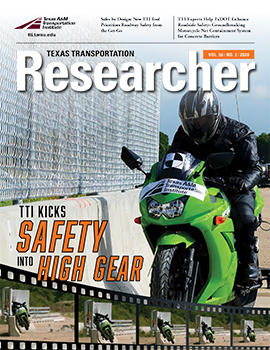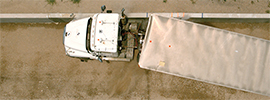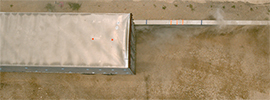A large, anxious crowd was gathered for a full-scale crash test on a hot July day in 2019. Although a rare event, using 18-wheelers to crash-test guardrails, bridge railings and, in this case, a concrete barrier, is always memorable.

And if the test (conducted at the Texas A&M Transportation Institute [TTI] Proving Grounds on The Texas A&M University System’s RELLIS Campus) was successful, it would mean that lives could be saved and bridge safety could be improved. The Texas Department of Transportation (TxDOT) was interested in ways to prevent trucks from crashing into bridge columns adjacent to older designed, high-speed roadways. The department sponsored the project, Analysis of 54-Inch Tall Single Slope Concrete Barrier on a Structurally Independent Foundation, with TTI to develop a new barrier.
The project developed the first 54-inch tall barrier with a structurally independent foundation to meet the new Manual for Assessing Safety Hardware (MASH) Test Level 5 testing requirements. The 18-wheeler’s trailer was loaded with 80,000 pounds and reached a speed of 50 mph before it rammed the barrier at a 15-degree angle. It was a short-lived thrill for the crash test newcomers, but for the TTI researchers and officials from TxDOT, a lot was riding on this moment.
The test was successful, demonstrating that the drilled shaft foundation and the barrier designed by TTI engineers combine to shield bridge columns adjacent to roadways from an 18-wheeler impact. This new design could soon be used across Texas as a test-proven tool in the toolbox.
“I was extremely pleased with the results,” TxDOT Bridge Standards Engineer Taya Retterer vividly recalls. “Our eyes were focused on the 54-inch- tall concrete barrier hit by the truck. We were very impressed that there was very little movement of the barrier and its foundation. It’s what we needed to see to know that the test passed.”
“Newly constructed bridges in Texas have columns that are already designed to survive a hit from an 18-wheeler, but that is not the case for some older bridges across the state,” explains TTI Associate Research Engineer Nauman Sheikh, the Institute’s research supervisor on the project.


According to Sheikh, an 18-wheeler hitting the columns of such bridges can be catastrophic, which speaks to the need for a barrier design and foundation system that can withstand such high-powered impacts. Before conducting expensive, real-world crash tests, however, Sheikh and his team relied on numerous design combinations, testing them via computer simulation before focusing on the drilled shaft foundation for crash testing. Those computer simulations were critical to determining foundation sizes and the depth of the shafts that would stand up to the high impact force of an 18-wheeler.
“The system kept the truck from penetrating the barrier,” Sheikh confirms. “In addition, the vehicle did not go over the installation and was safely directed away from the barrier, without much possibility of impacting any bridge columns behind the barrier.” Sheikh points out that when installing the system, the barrier should be 2 feet away from columns to make up for the 18-wheeler’s lean angle upon impact.
The TxDOT approval process for the new system is under way, and it should be available as an option for use as early as this summer.


